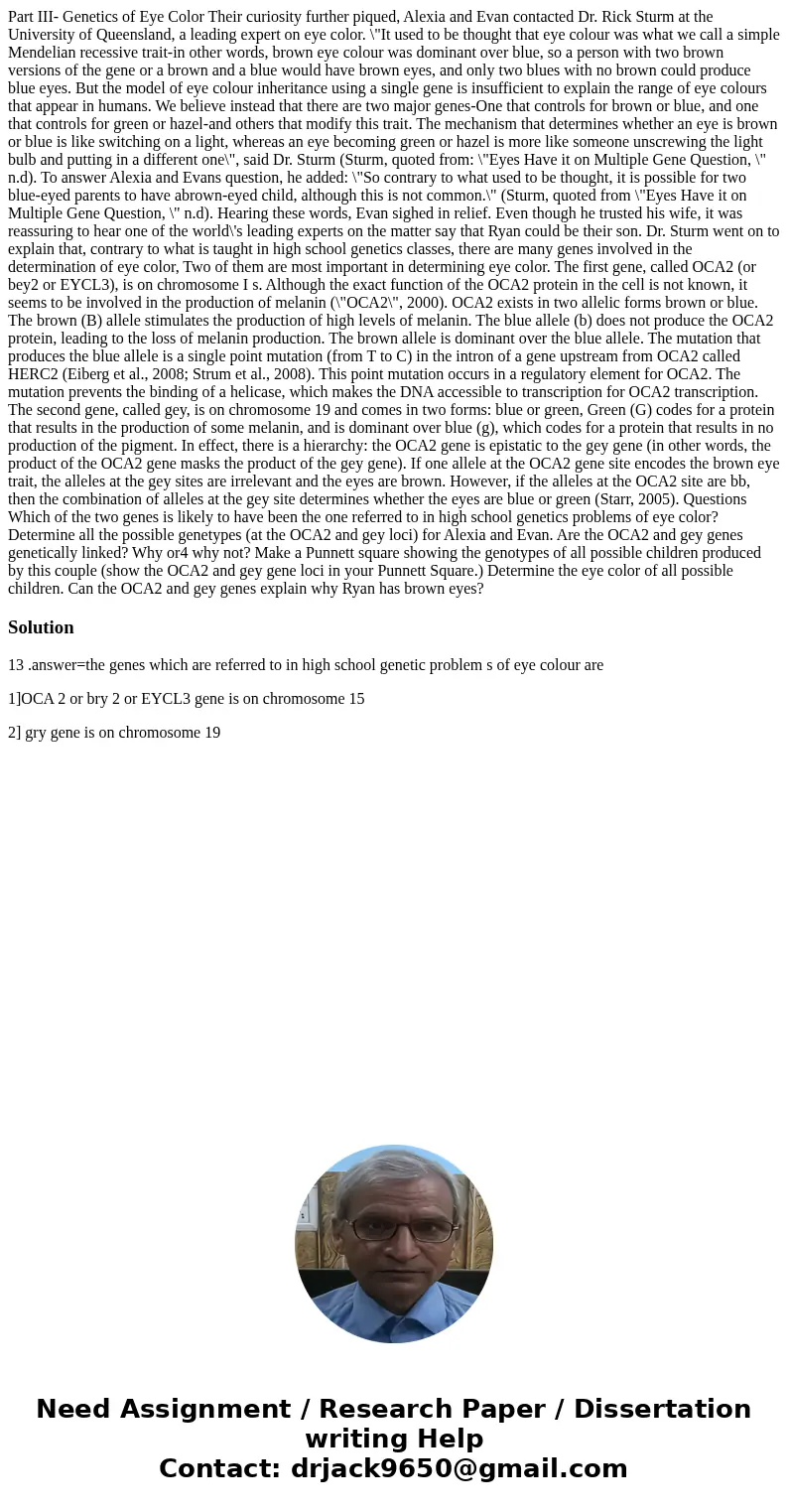Part III Genetics of Eye Color Their curiosity further pique
Part III- Genetics of Eye Color Their curiosity further piqued, Alexia and Evan contacted Dr. Rick Sturm at the University of Queensland, a leading expert on eye color. \"It used to be thought that eye colour was what we call a simple Mendelian recessive trait-in other words, brown eye colour was dominant over blue, so a person with two brown versions of the gene or a brown and a blue would have brown eyes, and only two blues with no brown could produce blue eyes. But the model of eye colour inheritance using a single gene is insufficient to explain the range of eye colours that appear in humans. We believe instead that there are two major genes-One that controls for brown or blue, and one that controls for green or hazel-and others that modify this trait. The mechanism that determines whether an eye is brown or blue is like switching on a light, whereas an eye becoming green or hazel is more like someone unscrewing the light bulb and putting in a different one\", said Dr. Sturm (Sturm, quoted from: \"Eyes Have it on Multiple Gene Question, \" n.d). To answer Alexia and Evans question, he added: \"So contrary to what used to be thought, it is possible for two blue-eyed parents to have abrown-eyed child, although this is not common.\" (Sturm, quoted from \"Eyes Have it on Multiple Gene Question, \" n.d). Hearing these words, Evan sighed in relief. Even though he trusted his wife, it was reassuring to hear one of the world\'s leading experts on the matter say that Ryan could be their son. Dr. Sturm went on to explain that, contrary to what is taught in high school genetics classes, there are many genes involved in the determination of eye color, Two of them are most important in determining eye color. The first gene, called OCA2 (or bey2 or EYCL3), is on chromosome I s. Although the exact function of the OCA2 protein in the cell is not known, it seems to be involved in the production of melanin (\"OCA2\", 2000). OCA2 exists in two allelic forms brown or blue. The brown (B) allele stimulates the production of high levels of melanin. The blue allele (b) does not produce the OCA2 protein, leading to the loss of melanin production. The brown allele is dominant over the blue allele. The mutation that produces the blue allele is a single point mutation (from T to C) in the intron of a gene upstream from OCA2 called HERC2 (Eiberg et al., 2008; Strum et al., 2008). This point mutation occurs in a regulatory element for OCA2. The mutation prevents the binding of a helicase, which makes the DNA accessible to transcription for OCA2 transcription. The second gene, called gey, is on chromosome 19 and comes in two forms: blue or green, Green (G) codes for a protein that results in the production of some melanin, and is dominant over blue (g), which codes for a protein that results in no production of the pigment. In effect, there is a hierarchy: the OCA2 gene is epistatic to the gey gene (in other words, the product of the OCA2 gene masks the product of the gey gene). If one allele at the OCA2 gene site encodes the brown eye trait, the alleles at the gey sites are irrelevant and the eyes are brown. However, if the alleles at the OCA2 site are bb, then the combination of alleles at the gey site determines whether the eyes are blue or green (Starr, 2005). Questions Which of the two genes is likely to have been the one referred to in high school genetics problems of eye color? Determine all the possible genetypes (at the OCA2 and gey loci) for Alexia and Evan. Are the OCA2 and gey genes genetically linked? Why or4 why not? Make a Punnett square showing the genotypes of all possible children produced by this couple (show the OCA2 and gey gene loci in your Punnett Square.) Determine the eye color of all possible children. Can the OCA2 and gey genes explain why Ryan has brown eyes?
Solution
13 .answer=the genes which are referred to in high school genetic problem s of eye colour are
1]OCA 2 or bry 2 or EYCL3 gene is on chromosome 15
2] gry gene is on chromosome 19

 Homework Sourse
Homework Sourse